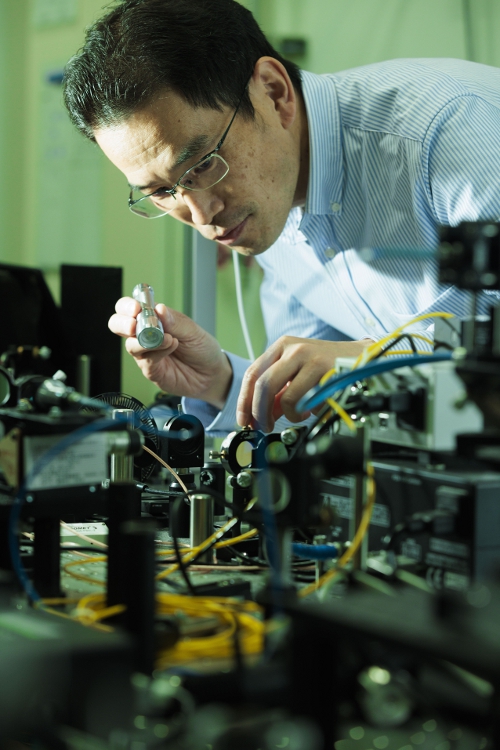A study of the spin and quantum functionalities generated by semiconductor spatial spin structures.
The affluent, safe, comfortable, and convenient lives that we enjoy today are largely due to the ever-evolving progress of electronic devices.
The development of electronic products, which control devices by controlling the charge of electrons and processing information with semiconductor devices, has been enabled by the miniaturization and integration of devices.
However, in the quantum information society of the future, where information will be handled on a completely different level than in our daily lives, including the Internet of Things (IoT), artificial intelligence (AI), and even quantum information, there are concerns about an explosive increase in the volume of information. This necessitates a revolution in information devices that is different from the extension of existing semiconductor integrated circuits.
The advent of new concepts of information processing based on “spintronics” and “quantum technology” and the associated new principles that make them possible will lead to this revolution.
The objective of our research is to identify and investigate various physical phenomena that can only be observed when electron spins are precisely controlled in semiconductors. Additionally, we aim to develop the functionality necessary for next-generation information processing devices.
Spintronics, as the name implies, utilizes the spin of electrons to realize new functionality that cannot be achieved with electric charge alone by controlling the electron spin.
Nevertheless, research to date has primarily concentrated on information processing and information recording using spin currents, in which the direction of the spin is uniformly aligned in space and time.
Recently, we have identified the stable spin rotation in space and the extreme control of spin state that acts as the electron spin waves (M. Kohda et al., Phys. Rev. B 86, 081306(R) (2012)).
The electron spin wave produces a new principle in which the electron spins do not align only in spin “up” or “down”, but rather rotate coherently with each other in space as if they were dancing a waltz.
We are pioneering a new research field, “Helical spintronics,” which utilizes the spatial structure of electron spins in semiconductors, and are aiming to create functionalities for ultra-fast and energy-saving quantum computers and next-generation information processing devices.
The similar research on the spatial structure of electron spins corresponds to the variety of physical phenomena produced by the spatial structure of magnetization in ferromagnetic materials.
Examples include magnons, which are spin waves produced by continuous changes in magnetic order, and topological properties of skyrmions, chiral domain walls, and noncollinear magnetic materials.
The spatial structure of these magnetic materials has been studied intensively worldwide, and research is currently underway to innovate basic concepts and device applications.
Why, then, has the spatial structure of electron spins in semiconductors not been clarified until now?
In the case of magnetic materials, the spatial structure of magnetic moments can be observed through magneto-optical and magneto-electrical measurements, which can be used to directly detect local magnetization or to observe resistance changes via conduction electrons, and many other detection methods exist. This is because the spontaneous magnetization can be detected by these techniques.
On the other hand, semiconductors are nonmagnetic materials with zero net spin polarization , so the spatial structure of spin itself does not usually appear in semiconductors in the steady state. This is because it needs to be stimulated from the outside to induce non-equilibrium states.
Furthermore, the relatively short electron spin relaxation time in semiconductors limits the detection time in which the spatial structure of spins can be observed
For these reasons, the spatial spin structure of semiconductors has been hidden, so to speak..
However, the discovery of a principle that can stabilize the spatial spin structure will lead to the development of various spin structures in semiconductors and will increase opportunities to encounter new physical phenomena and new functionalities based on spatial spin structures.
Above all, we can expect to observe the variety of physical properties of spin structures not only in semiconductors but also in magnetic materials, and there is the possibility of discovering more universal physical properties and principles related to the spatial spin structures, independent of semiconductors and magnetic materials.

Another pillar of the Kohda Laboratory’s efforts is the development of novel spin properties using various semiconductor materials and their application to next-generation information devices.
In addition to semiconductors such as silicon and GaAs, many semiconductor materials with unprecedented functions have been discovered in recent years, such as atomic layered materials and quantum materials.
By clarifying the unique properties of these diverse semiconductors, we may be able to find new physical phenomena and associated novel functionalities that have not been achieved in electronics until now, which includes valley degree of freedom and orbital currents as well as spin currents.
The electron spin wave caused by the spatial propagation of spin rotation has completely different properties from those of conventional “up” and “down” spins, and thus has the potential to solve the problems of current semiconductor integrated circuits, such as the rapid increase in power consumption and signal delays due to the limits of miniaturization. This could be a great potential to solve the problems of rapid increase in power consumption and signal delays caused by the limitations of miniaturization in current semiconductor integrated circuits.
The most exciting part of research is being able to confront for the first time in the world a phenomenon that no one has ever known before.
Kohda Laboratory aims to contribute to future technologies such as next-generation information processing and quantum technology, and to work hard and take on challenges so that our dreams do not end as dreams.
The research themes in the Kohda Laboratory encompass the following areas:
Helical Spintronics
Quantum Spintronics
Metal Spintronics
Copyright c 2023 Kohda Laboratory Tohoku University



